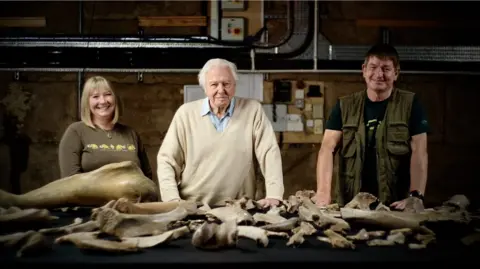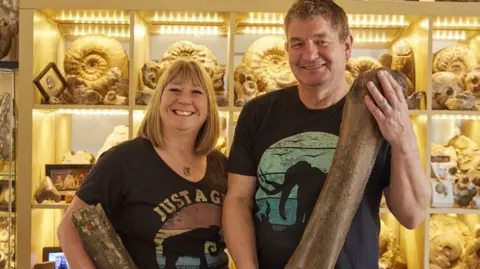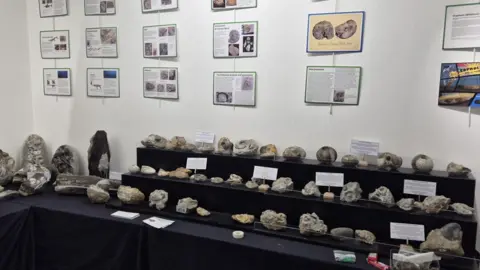Mammoth graveyard artefacts on display for first time
 Windfall Films
Windfall FilmsThe remains of a mammoth and other artefacts which inspired a David Attenborough documentary are on display at a Gloucestershire museum.
Mammoth teeth, a marine crocodile skull and a tooth from a straight-tusked elephant are among can be viewed at the Corinium Museum in Cirencester.
The items were dug up from a site in Cerney Wick known as "mammoth graveyard", where multiple remains of steppe mammoths were found in 2019.
New fossils from a dig completed in the summer of 2024, which have never been displayed before, are on display at the museum from 15 February until 15 March.
 David Vintiner
David Vintiner"It's been an amazing achievement," said Sally Hollingworth, who led the project with her husband Dr Neville Hollingworth.
Mrs Hollingworth explained how the dig began in 2017 when she found spotted a Neanderthal hand axe.
"That's what led to the Attenborough and the Mammoth Graveyard documentary," she said.
The site is believed to date back to 220,000 years ago.
"The finds that were from the site were truly unique," said Dr Hollingworth.
"It's an internationally important location, because there's very few locations around where you'll find Neanderthal stone tools mixed up with mammoth bones and ice age animals."
Mrs Hollingworth explained the site also has fossils and ammonites from the Middle Jurassic Period, dating back 167 million years.
 Sally Hollingworth
Sally HollingworthThe dig involved experts, volunteers and students from 20 universities from across the country, with most of them camping at the site.
"We managed to get material from the quarry floor to museum display within six months - that's pretty unique in the palaeontology world," said Mrs Hollingworth.
Dr Hollingworth described the dig as a "brilliant piece of co-operative work" and said it often takes years for finds like these to go on display.
Following the exhibition, the Hollingworths plan for the fossils to tour around other museums in the south west.
The longer-term plan is to build a new biodiversity centre in the Cotswolds Lake area, keeping the fossils local to the area.
Follow BBC Gloucestershire on Facebook, X and Instagram. Send your story ideas to us on email or via WhatsApp on 0800 313 4630.
